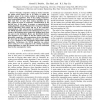901 search results - page 130 / 181 » Minimum power configuration in wireless sensor networks |
PIMRC
2008
IEEE
14 years 3 months ago
2008
IEEE
— The inherent near-far effect in wireless networks causes nodes that are further away from the receiver to suffer from throughput degradation, as packets from nodes that are nea...
IPSN
2010
Springer
14 years 3 months ago
2010
Springer
bstract: User-Centric Radio Power Control for Opportunistic Mountain Hiking Networks ∗ Jyh-How Huang1 , Po-Yen Lin1 , Yu-Te Huang2 , Seng-Yong Lau1 , Ling-Jyh Chen2 , Kun-chan La...
SENSYS
2003
ACM
14 years 2 months ago
2003
ACM
Experience has shown that the power consumption of sensors and other wireless computational devices is often dominated by their communication patterns. We present a practical real...
WWW
2006
ACM
14 years 9 months ago
2006
ACM
In bridging the digital divide, two important criteria are cost-effectiveness, and power optimization. While 802.11 is cost-effective and is being used in several installations in...
GLOBECOM
2007
IEEE
14 years 19 days ago
2007
IEEE
Recently, cooperative routing in wireless networks has gained much interest due to its ability to exploit the broadcast nature of the wireless medium in designing powerefficient ro...

